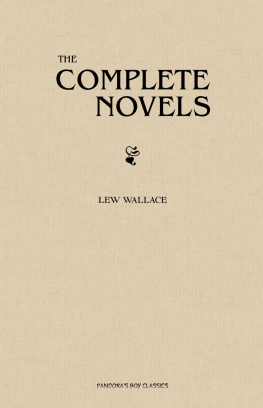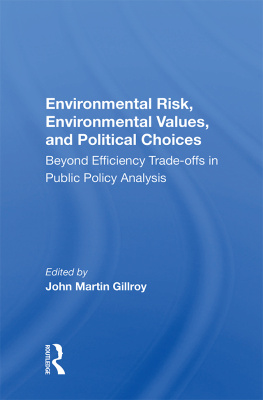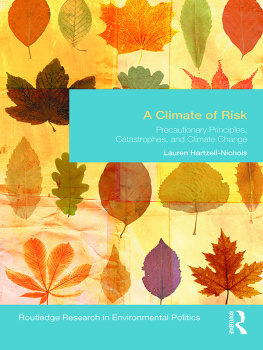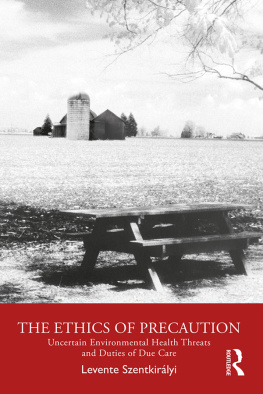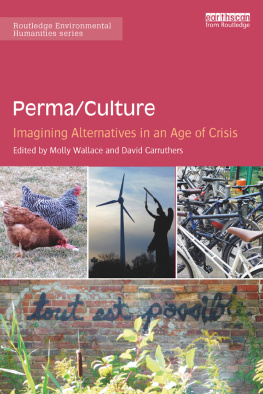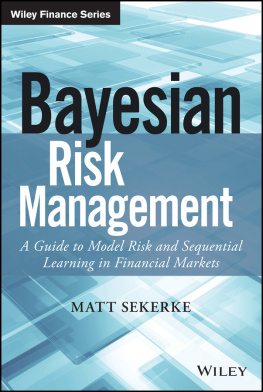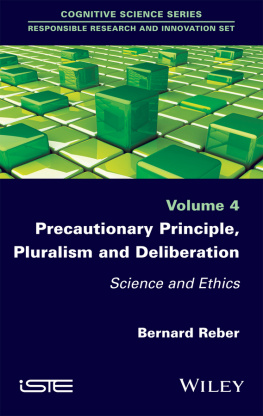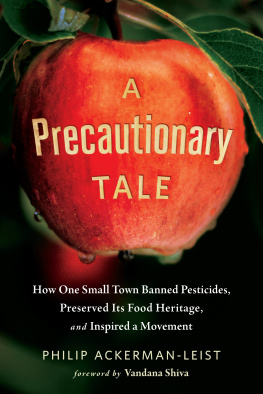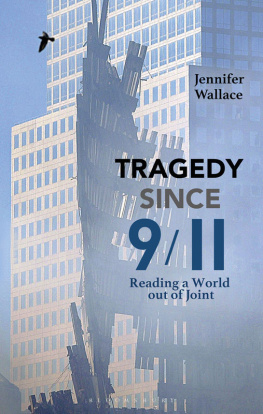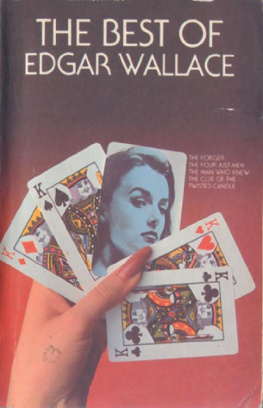Molly Wallace - Risk Criticism: Precautionary Reading in an Age of Environmental Uncertainty
Here you can read online Molly Wallace - Risk Criticism: Precautionary Reading in an Age of Environmental Uncertainty full text of the book (entire story) in english for free. Download pdf and epub, get meaning, cover and reviews about this ebook. year: 2018, publisher: University of Michigan Press, genre: Politics. Description of the work, (preface) as well as reviews are available. Best literature library LitArk.com created for fans of good reading and offers a wide selection of genres:
Romance novel
Science fiction
Adventure
Detective
Science
History
Home and family
Prose
Art
Politics
Computer
Non-fiction
Religion
Business
Children
Humor
Choose a favorite category and find really read worthwhile books. Enjoy immersion in the world of imagination, feel the emotions of the characters or learn something new for yourself, make an fascinating discovery.

- Book:Risk Criticism: Precautionary Reading in an Age of Environmental Uncertainty
- Author:
- Publisher:University of Michigan Press
- Genre:
- Year:2018
- Rating:5 / 5
- Favourites:Add to favourites
- Your mark:
- 100
- 1
- 2
- 3
- 4
- 5
Risk Criticism: Precautionary Reading in an Age of Environmental Uncertainty: summary, description and annotation
We offer to read an annotation, description, summary or preface (depends on what the author of the book "Risk Criticism: Precautionary Reading in an Age of Environmental Uncertainty" wrote himself). If you haven't found the necessary information about the book — write in the comments, we will try to find it.
Molly Wallace: author's other books
Who wrote Risk Criticism: Precautionary Reading in an Age of Environmental Uncertainty? Find out the surname, the name of the author of the book and a list of all author's works by series.
Risk Criticism: Precautionary Reading in an Age of Environmental Uncertainty — read online for free the complete book (whole text) full work
Below is the text of the book, divided by pages. System saving the place of the last page read, allows you to conveniently read the book "Risk Criticism: Precautionary Reading in an Age of Environmental Uncertainty" online for free, without having to search again every time where you left off. Put a bookmark, and you can go to the page where you finished reading at any time.
Font size:
Interval:
Bookmark:
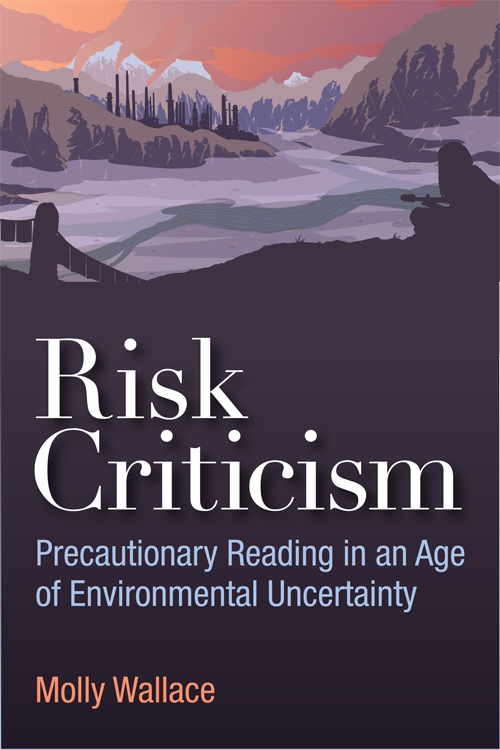 Page i
Page i Molly Wallace
University of Michigan Press
Ann Arbor
Page ivCopyright 2016 by Molly Wallace
All rights reserved
This book may not be reproduced, in whole or in part, including illustrations, in any form (beyond that copying permitted by Sections 107 and 108 of the U.S. Copyright Law and except by reviewers for the public press), without written permission from the publisher.
Published in the United States of America by the
University of Michigan Press
A CIP catalog record for this book is available from the British Library.
Library of Congress Cataloging-in-Publication Data
Names: Wallace, Molly, author.
Title: Risk criticism : precautionary reading in an age of environmental uncertainty / Molly Wallace.
Description: Ann Arbor : University of Michigan Press, 2016. | Includes bibliographical references and index.
Identifiers: LCCN 2015038637 | ISBN 9780472073023 (hardback) | ISBN 9780472053025 (paperback) | ISBN 9780472121694 (ebook)
Subjects: LCSH: Ecocriticism. | Criticism. | Risk in literature. | Environmental risk assessment. | Risk-taking (Psychology)
Classification: LCC PN98.E36 W35 2016 | DDC 809/.93355dc23
LC record available at http://lccn.loc.gov/2015038637
For my family
Page vi Page viiThis book has been a number of years in the writing, and I am deeply grateful for the support and encouragement that I have received along the way. To my colleagues at Queens University, I owe a debt of gratitude for your support and inspiration. Thanks particularly to Mick Smith in the School of Environmental Studies and Asha Varadharajan in the Department of English, both of whom let me test out some ideas on their unwitting students. And thanks too to the students in my own courses on nuclear culture and risk for thoughtful engagement and challenges. In the wider world, thanks are due to Rob Nixon, for his encouragement and inspiration, and to Begoa Simal-Gonzlez, whose invitation to deliver a lecture in Spain seemed too good to be true, and who, in addition to friendship, offered the opportunity to share portions of what is now chapter 3. I am also deeply grateful to Catriona Sandilands for her immense intellectual and personal generosity, including the invitation to deliver a closing keynote address at the Green Words / Green Worlds conference in Toronto, which gave me the opportunity to craft an early version of chapter 5. A version of that keynote (and now a proto-version of the final chapter of this book) is forthcoming, as Averting Environmental Catastrophe in Time: Staging the Uranium Cycle, in a volume that Cate and Amanda Di Battista are coediting for Wilfrid Laurier Press; my thanks to the Press for permission to include a version of it here. Other portions of the book have also appeared elsewhere. A variant of the introduction appeared as Will the Apocalypse Have Been Now? Literary Criticism in an Age of Global Risk in Criticism, Crisis, and Contemporary Narrative: Textual Horizons in an Age of Global Risk, edited by Paul Crosthwaite (Routledge, 2011). My thanks to Paul for organizing the marvelous conference on risk for which the paper was originally written. An earlier version of chapter 3 appeared as Discomfort Food: Analogy, Biotechnology, and Risk in Ruth Ozekis All Over Creation in Arizona Quarterly 67.4 (Winter 2011).
My thanks as well to those who have provided permission for the images in this book, the Bulletin of the Atomic Scientists; the Argonne National Page viii Library; Heal the Bay; Boom Entertainment (for the image from Im Not a Plastic Bag Rachel Allison. All rights reserved. Used with permission); John Hendrix; the Maruki Gallery for the Hiroshima Panels; and John Junkerman (and the Maruki Film Project). I am grateful also to Adam Dickinson and House of Anansi Press and Ronald Wallace and the University of Pittsburgh Press for granting permission to reprint poems. Risk Criticism was supported with a Standard Research Grant from the Social Sciences and Humanities Research Council of Canada (SSHRC). My thanks to my Research Assistants who contributed immensely to the project: Maryanne Laurico, Laura McGavin, Aaron Mauro, David Carruthers, and Shadi Ghazimoradi. The staff at the University of Michigan Press has been unfailingly professional and tremendously supportive. Thanks especially to Aaron McCollough for his support of the book, to the two anonymous reviewers for their generous engagement with the manuscript, and to those on the Press Committee, who provided wise council for final revisions.acknowledgments
This project would not have been possible without the guidance and example of my parents, whose commitment to literature and justice is a constant inspiration, and whose loving support has sustained me. I owe many thanks to Todd, builder of native gardens, birdhouses, and rocket-mass heaters, who has championed me unflaggingly, and to Lucy, lover of worms, birds, cats, humans, and all other planetary life, who is teaching me hope. As I was readying the manuscript for submission, I received word that Ulrich Beck, the source of so much inspiration for my work, had died. I would like also, then, to acknowledge the deep debt I owe to him, and offer thanks for his life and work.
This research was supported by the Social Sciences and Humanities Research Council of Canada.
Page ixGiven its impalpability, its lubricity, can this protracted apocalypse be grasped, or only sensed faintly as we slip listlessly through it?
Andrew McMurray, The Slow Apocalypse
The future inhabits the present, yet it also has not yet comerather like the way toxics inhabit the bodies of those exposed, setting up the future, but not yet manifest as disease, or even as an origin from which a specific and known disease will come.
Kim Fortun, Advocacy after Bhopal
From the start of what, in retrospect, may have been the first nuclear age, perhaps no image has so captured the sense of looming risk that nuclear weapons pose as the Bulletin of the Atomic Scientistss Doomsday Clock, an icon that has graced the cover of that publication since 1947. From its perilously close two minutes to midnight following the detonation of the first thermonuclear bombs, first by the United States and then by the Soviets, in 1953 to its position at a relatively comfortable seventeen minutes to midnight in 1991, the Clock has stood as a barometer of the worlds proximity to its end. With the end of the Cold War, this icon might seem to have joined duck-and-cover drills and fallout shelters as an archaic relic of the atomic age; nevertheless, it has continued to mark the timesand has marched fairly steadily toward midnight, from fourteen minutes in 1995, to nine in 1998, to seven in 2002, each tick reminding us that, though the cultural obsession with the nuclear may have waned, we continue to live under the shadow of the atomic bomb.
But even as it represents the continuity of risk, the Clock has also Page 2 changed with the times. Indeed, when it appeared on the JanuaryFebruary 2007 issue of the publicationreset to five minutes to midnightits symbolic valence had subtly changed. Still measuring nuclear threatsthe United States then-interest in usable nukes, the spread of weapons to North Korea and potentially Iran, and the resurgence of investment in nuclear powerthe Clock had also begun to register other risks that the
Next pageFont size:
Interval:
Bookmark:
Similar books «Risk Criticism: Precautionary Reading in an Age of Environmental Uncertainty»
Look at similar books to Risk Criticism: Precautionary Reading in an Age of Environmental Uncertainty. We have selected literature similar in name and meaning in the hope of providing readers with more options to find new, interesting, not yet read works.
Discussion, reviews of the book Risk Criticism: Precautionary Reading in an Age of Environmental Uncertainty and just readers' own opinions. Leave your comments, write what you think about the work, its meaning or the main characters. Specify what exactly you liked and what you didn't like, and why you think so.

